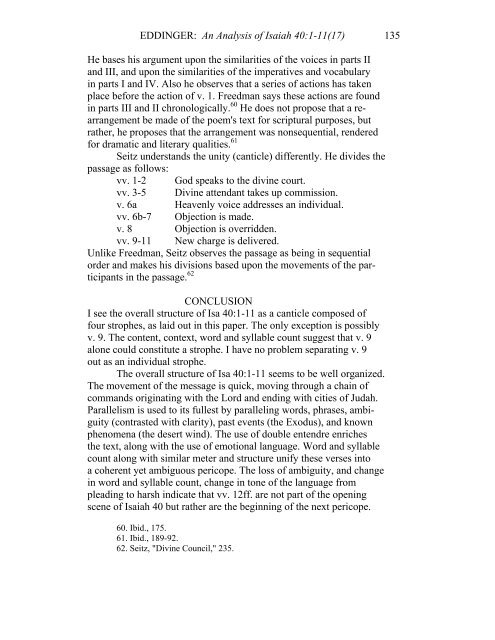An Analysis of Isaiah 40:1-11(17) - Institute for Biblical Research
An Analysis of Isaiah 40:1-11(17) - Institute for Biblical Research
An Analysis of Isaiah 40:1-11(17) - Institute for Biblical Research
You also want an ePaper? Increase the reach of your titles
YUMPU automatically turns print PDFs into web optimized ePapers that Google loves.
EDDINGER: <strong>An</strong> <strong>An</strong>alysis <strong>of</strong> <strong>Isaiah</strong> <strong>40</strong>:1-<strong>11</strong>(<strong>17</strong>) 135<br />
He bases his argument upon the similarities <strong>of</strong> the voices in parts II<br />
and III, and upon the similarities <strong>of</strong> the imperatives and vocabulary<br />
in parts I and IV. Also he observes that a series <strong>of</strong> actions has taken<br />
place be<strong>for</strong>e the action <strong>of</strong> v. 1. Freedman says these actions are found<br />
in parts III and II chronologically. 60 He does not propose that a rearrangement<br />
be made <strong>of</strong> the poem's text <strong>for</strong> scriptural purposes, but<br />
rather, he proposes that the arrangement was nonsequential, rendered<br />
<strong>for</strong> dramatic and literary qualities. 61<br />
Seitz understands the unity (canticle) differently. He divides the<br />
passage as follows:<br />
vv. 1-2 God speaks to the divine court.<br />
vv. 3-5 Divine attendant takes up commission.<br />
v. 6a Heavenly voice addresses an individual.<br />
vv. 6b-7 Objection is made.<br />
v. 8 Objection is overridden.<br />
vv. 9-<strong>11</strong> New charge is delivered.<br />
Unlike Freedman, Seitz observes the passage as being in sequential<br />
order and makes his divisions based upon the movements <strong>of</strong> the participants<br />
in the passage. 62<br />
CONCLUSION<br />
I see the overall structure <strong>of</strong> Isa <strong>40</strong>:1-<strong>11</strong> as a canticle composed <strong>of</strong><br />
four strophes, as laid out in this paper. The only exception is possibly<br />
v. 9. The content, context, word and syllable count suggest that v. 9<br />
alone could constitute a strophe. I have no problem separating v. 9<br />
out as an individual strophe.<br />
The overall structure <strong>of</strong> Isa <strong>40</strong>:1-<strong>11</strong> seems to be well organized.<br />
The movement <strong>of</strong> the message is quick, moving through a chain <strong>of</strong><br />
commands originating with the Lord and ending with cities <strong>of</strong> Judah.<br />
Parallelism is used to its fullest by paralleling words, phrases, ambiguity<br />
(contrasted with clarity), past events (the Exodus), and known<br />
phenomena (the desert wind). The use <strong>of</strong> double entendre enriches<br />
the text, along with the use <strong>of</strong> emotional language. Word and syllable<br />
count along with similar meter and structure unify these verses into<br />
a coherent yet ambiguous pericope. The loss <strong>of</strong> ambiguity, and change<br />
in word and syllable count, change in tone <strong>of</strong> the language from<br />
pleading to harsh indicate that vv. 12ff. are not part <strong>of</strong> the opening<br />
scene <strong>of</strong> <strong>Isaiah</strong> <strong>40</strong> but rather are the beginning <strong>of</strong> the next pericope.<br />
60. Ibid., <strong>17</strong>5.<br />
61. Ibid., 189-92.<br />
62. Seitz, "Divine Council," 235.
















